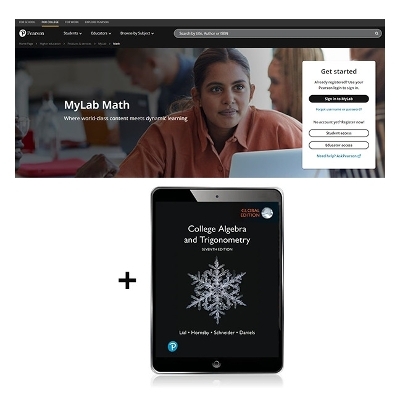
College Algebra and Trigonometry, Global Edition -- MyLab Math with Pearson eText
Pearson (Hersteller)
978-0-6557-1229-9 (ISBN)
- Titel nicht im Sortiment
- Artikel merken
Pearson MyLab is the world's leading online self-study, homework, tutorial and assessment product designed with a single purpose in mind: to improve the results of all higher education students, one student at a time.
To access the MyLab you need a Course ID from your instructor.
Marge Lial (late) was always interested in math; it was her favourite subject in the first grade! Marge's intense desire to educate both her students and herself has inspired the writing of numerous best-selling textbooks. Marge, who received Bachelor's and Master's degrees from California State University at Sacramento, was affiliated with American River College. An avid reader and traveller, her travel experiences often found their way into her books as applications, exercise sets, and feature sets. Her interest in archeology led to trips to various digs and ruin sites, producing some fascinating problems for her textbooks involving such topics as the building of Mayan pyramids and the acoustics of ancient ball courts in the Yucatan. When John Hornsby enrolled as an undergraduate at Louisiana State University, he was uncertain whether he wanted to study mathematics education or journalism. His ultimate decision was to become a teacher, but after twenty-five years of teaching at the high school and university levels and fifteen years of writing mathematics textbooks, both of his goals have been realised. His love for both teaching and for mathematics is evident in his passion for working with students and fellow teachers as well. David I. Schneider spent over 32 years teaching at the University of Maryland and has published an impressive 28 books over the past 18 years. He is the author of several best-selling texts, including his Visual Basic Series. Students love his extensive use of examples and applications: a concept that stems from his teaching experience and results in books that are 'tried and true.' His best-selling Visual Basic texts have been successfully used for many years and have received consistent praise from both students and instructors. Callie Daniels has always had a passion for learning mathematics and brings that passion into the classroom with her students. She attended the University of the Ozarks where she earned a bachelor's degree in Secondary Mathematics Education. She has two master's degrees: one in Applied Mathematics and Statistics from the University of Missouri - Rolla, the second in Adult Education from the University of Missouri - St. Louis. Her professional interests include improving success in the community college mathematics sequence, using technology to enhance students' understanding of mathematics, and creating materials that support classroom teaching and student understanding. She is able to pursue these interests as a contributor on the Lial Developmental Math series, and a co-author on the Precalculus series.
R. Review of Basic Concepts
R.1. Fractions, Decimals, and Percents
R.2. Sets and Real Numbers
R.3. Real Number Operations and Properties
R.4. Integer and Rational Exponents
R.5. Polynomials
R.6. Factoring Polynomials
R.7. Rational Expressions
R.8. Radical Expressions
1. Equations and Inequalities
1.1. Linear Equations
1.2. Applications and Modeling with Linear Equations
1.3. Complex Numbers
1.4. Quadratic Equations
1.5. Applications and Modeling with Quadratic Equations
1.6. Other Types of Equations and Applications
1.7. Inequalities
1.8. Absolute Value Equations and Inequalities
2. Graphs and Functions
2.1. Rectangular Coordinates and Graphs
2.2. Circles
2.3. Functions
2.4. Linear Functions
2.5. Equations of Lines and Linear Models
2.6. Graphs of Basic Functions
2.7. Graphing Techniques
2.8. Function Operations and Composition
3. Polynomial and Rational Functions
3.1. Quadratic Functions and Models
3.2. Synthetic Division
3.3. Zeros of Polynomial Functions
3.4. Polynomial Functions: Graphs, Applications, and Models
3.5. Rational Functions: Graphs, Applications, and Models
3.6. Polynomial and Rational Inequalities
3.7. Variation
4. Inverse, Exponential, and Logarithmic Functions
4.1. Inverse Functions
4.2. Exponential Functions
4.3. Logarithmic Functions
4.4. Evaluating Logarithms and the Change-of-Base Theorem
4.5. Exponential and Logarithmic Equations
4.6. Applications of Models of Exponential Growth and Decay
5. Trigonometric Functions
5.1. Angles
5.2. Trigonometric Functions
5.3. Trigonometric Function Values and Angle Measures
5.4. Solutions and Applications of Right Triangles
6. The Circular Functions and Their Graphs
6.1. Radian Measure
6.2. The Unit Circle and Circular Functions
6.3. Graphs of the Sine and Cosine Functions
6.4. Translations of the Graphs of the Sine and Cosine Functions
6.5. Graphs of the Tangent and Cotangent Functions
6.6. Graphs of the Secant and Cosecant Functions
6.7. Harmonic Motion
7. Trigonometric Identities and Equations
7.1. Fundamental Identities
7.2. Verifying Trigonometric Identities
7.3. Sum and Difference Identities
7.4. Double-Angle and Half-Angle Identities
7.5. Inverse Circular Functions
7.6. Trigonometric Equations
7.7. Equations Involving Inverse Trigonometric Functions
8. Applications of Trigonometry
8.1. The Law of Sines
8.2. The Law of Cosines
8.3. Geometrically Defined Vectors and Applications
8.4. Algebraically Defined Vectors and the Dot Product
8.5. Trigonometric (Polar) Form of Complex Numbers; Products and Quotients
8.6. De Moivre's Theorem; Powers and Roots of Complex Numbers
8.7. Polar Equations and Graphs
8.8. Parametric Equations, Graphs, and Applications
9. Systems and Matrices
9.1. Systems of Linear Equations
9.2. Matrix Solution of Linear Systems
9.3. Determinant Solution of Linear Systems
9.4. Partial Fractions
9.5. Nonlinear Systems of Equations
9.6. Systems of Inequalities and Linear Programming
9.7. Properties of Matrices
9.8. Matrix Inverses
10. Analytic Geometry
10.1. Parabolas
10.2. Ellipses
10.3. Hyperbolas
10.4. Summary of the Conic Sections
11. Further Topics in Algebra
11.1. Sequences and Series
11.2. Arithmetic Sequences and Series
11.3. Geometric Sequences and Series
11.4. The Binomial Theorem
11.5. Mathematical Induction
11.6. Basics of Probability
Appendix A Polar Form of Conic Sections
Appendix B Rotation of Axes
Appendix C Geometry Formulas
| Erscheint lt. Verlag | 9.2.2023 |
|---|---|
| Sprache | englisch |
| ISBN-10 | 0-6557-1229-1 / 0655712291 |
| ISBN-13 | 978-0-6557-1229-9 / 9780655712299 |
| Zustand | Neuware |
| Informationen gemäß Produktsicherheitsverordnung (GPSR) | |
| Haben Sie eine Frage zum Produkt? |